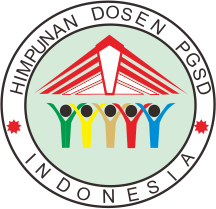THE EFFECTIVENESS OF STEM BASED LEARNING IN IMPROVING SCIENTIFIC THINKING ABOUT GRADE V OF ELEMENTARY SCHOOL
DOI:
https://doi.org/10.30595/dinamika.v13i1.9320Keywords:
Scientific Attitudes, Science Learning, STEMAbstract
This study is backgrounded by student’s scientific attitude which is still low in process of Natural Sciences in grade V SD/MI. The present study aimed to determine the improvement of scientific attitudes by using learning based on Science, Technology, Engineering, and Mathematics (STEM). This study is a class action research. Subjects of this study are students of class V in MI Muhammadiyah Kramat with a total of 20 students, consisting of 15 men and 5 women. The instrument used is a questionnaire and a scientific attitude observation sheet as well as a science learning achievement test. The results of this study there is an increase in scientific attitudes and learning achievement using the STEM model in grade V. Based on the questionnaire scientific attitude in the first cycle to get an average score of 3.7 or 74% which includes good criteria and then increased in the second cycle to get an average score of 4.2 or 84% which includes good criteria. Improvement of science learning achievement in the first cycle got an average value of 55.1 with 40.3% mastery learning and cycle II got an average value of 71.65 with 82% mastery learning. Each stage in STEM can facilitate the improvement of scientific attitudes in learning science in grade V SD/MIReferences
[1] Samatowa, U. (2010). Pembelajaran IPA di Sekolah Dasar. Jakarta: PT. Indeks.
[2] Harlen, W. (1993). Teaching and Learning Primary Science. London. Paul Chapman Publishing Ltd.
[3] Rapi N.K (2008). Implementasi Siklus Belajar Hipotesis-Deduktif untuk Meningkatkan Sikap Ilmiah dan Keterampilan Proses IPA di SMAN 4 Singaraja. Jurnal Pendidikan dan Pengajaran. no. 3. 701-720.
[4] Chandra, D.T. (2007) Memilih Buku Pelajaran IPA. http://pelangi.ditplp.go.id.
[5] Hayat, M.S., Anggraeni, S. & Redjeki, S. (2011). Pembelajaran Berbasis Praktikum pada Konsep Invertebrata untuk Pengembangan Sikap Ilmiah Siswa. Jurnal Bioma. 1(2). 141-152.
[6] Singh, K.V. (2016). A Study of the Relationship between Scientific Attitude and Academic Achievement of Rural Area’s Intermediate College Girl (science stream only). International Journal of applied research. 2(4). 46-49
[7] Slameto. (2010). Belajar dan Faktor-Faktor yang Mempengaruhinya. Jakarta: Rienaka Cipta.
[8] Hannover Research. (2011). Successful K-12 STEM Education: Identifying Effective Approaches in Science, Technology, Engineering, and Mathematics. Washington, DC: National Academies Press.
[9] Torlakson. T. (2014). Innovate A Blueprint for Science, Technology, Engineering, and Mathematics in California Public Education. California: State Superintendent of Public Instruction.
[10] Pfeiffer, H.D, Ignatov, D.I., & Poelmans, J. (2013). Conceptual Structures for STEM Research and Education. 20th International Conference on Conceptual Structures, Proceedings ICCS 2013 January 10-12. Mumbai: Springer.
[11] Afriana, J., Permanasari, A. & Fitriani, A. (2016). Project-Based Learning Integrated To Stem To Enhance Elementary School’s Students Scientific Literacy. Jurnal Pendidikan IPA Indonesia. JPII, 5 (2). 261-267
[12] Sari, R.H. (2017). Pengaruh Implementasi Pembelajaran STEM terhadap Persepsi, Sikap, dan Kreativitas Siswa. Prosiding Seminar Nasional MIPA III. Langsa-Aceh, October 30, available in: http://www.conference.unsyiah.ac.id/SN-MIPA
[13] Gonzalez, H.B. & Kuenzi, J. J. (2012). Science, Technology, Engineering, and Mathematics (STEM) Education: A Primer. Congressional Research Service.
[14] White, D.W. (2010). What Is STEM Education and Why Is It Important?. Florida Association of Teacher Educators Journal. 1(14). 1-9.
[15] Kemmis, S & Robin Mc.Taggart. (1982). The Action Research Planner. Victoria: Deakin University Press.
[16] Alawiyah, I & Sopandi, W. (2016). Pembelajaran Berbasis Proyek untuk Meningkatkan Sikap Ilmiah Siswa Sekolah Dasar pada Materi Peristiwa Alam. Jurnal Penelitian Pendidikan UPI. ISSN: 1412-565X. 167 – 176
[17] Laboy-Rush, D. (2019). Integrated STEM Education through Project-based Learning. 2010. (Online) (www.learning.com/stem/whitepaper/integrated-STEM-throughProject-basedLearning), accessed on October 10.
[18] Jauhariyyah, F.R., Suwono, H., & Ibrohim. (2017). Science, Technology, Engineering, and Mathematics Project Based Learning (STEM-PjBL) pada Pembelajaran Sains. Prosseding Seminar Pendidikan IPA Pascasarjana UM. Vol.2. 432-436
[19] Mulyasa, E. (2015). Menjadi Guru Profesional (Menciptakan Pembelajaran Kreatif dan Menyenangkan). Bandung: PT Remaja Rosda Karya.
[20] Karli, H. (2011). Pendekatan Ketrampilan Proses untuk Meningkatkan Sikap Ilmiah pada Mata Pelajaran IPA Siswa Kelas III SD “X” Serpong. Jurnal Pendidikan Dasar UPI. 3(1), 1-15
[21] Ismayani, A. (2016). Pengaruh Penerapan STEM Project- based Learning terhadap Kreativitas Matematis siswa SMK. Indonesian Digital Journal of Mathematics and Education. 3(4), 264–272.
[22] Utami, T.N., Jatmiko, A., & Suherman. (2018). Pengembangan Modul Matematika dengan Pendekatan Science, Technology, Engineering, and Mathematics (STEM) pada Materi Segiempat. Desimal: Jurnal Matematika. 1
Additional Files
Published
How to Cite
Issue
Section
License
Authors who publish with this journal agree to the following terms:
Authors retain copyright and grant the journal right of first publication with the work simultaneously licensed under a Creative Commons Attribution License that allows others to share the work with an acknowledgement of the work's authorship and initial publication in this journal.
Authors are able to enter into separate, additional contractual arrangements for the non-exclusive distribution of the journal's published version of the work (e.g., post it to an institutional repository or publish it in a book), with an acknowledgement of its initial publication in this journal.
Authors are permitted and encouraged to post their work online (e.g., in institutional repositories or on their website) prior to and during the submission process, as it can lead to productive exchanges, as well as earlier and greater citation of published work (See The Effect of Open Access).

Dinamika Jurnal Ilmiah Pendidikan Dasar is licensed under a Creative Commons Attribution 4.0 International License.














